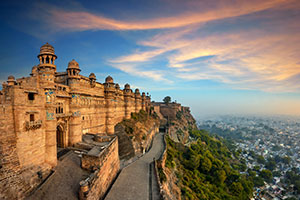FIRST-CLASS | SMALL GROUP: Experience the rich culture, heritage and diverse landscape of Northern India by visiting incredible destinations including Delhi, Jaipur, Ranthambore National Park, Agra, Lucknow, and Varanasi. Explore ancient forts and monuments, experience wildlife, and immerse yourself in spiritual and cultural traditions.
Varanasi
Varanasi
Picturesquely situated on the crescent shaped left bank of the holy Ganga, Varanasi, one of the ancient seats of learning in India, is said to be a compound of the names of two streams, the Varuna and the Assi, which still flow in the north and south of the city respectively. This name seems to have been corrupted, in medieval times to Banaras, which was in use till May 24, 1956 when it was changed to Varanasi, by an order of the Government of India. Varanasi is probably one of the most ancient living cities in India. From time immemorial it has been a great religious center for Hindus and one of their most sacred places of pilgrimage, being visited by millions of people every year. At a distance of 12 km from Varanasi lies Sarnath, where Lord Buddha preached his first sermon. Here he revealed the eight fold path that leads to the attainment of inner peace, Enlightment and Ultimate Nirvana.
|
Destination Guide
|
Lucknow
Lucknow
Located in north-central India 260 mi/420 km southeast of Delhi and not far from the border with Nepal, Lucknow has gardens, parks and the beautiful Bara Imambara tomb (an enormous tomb of a Shiite holy man). Lucknow was the site of the Uprising of 1857 against the British. Although it was ultimately unsuccessful, it was the first dramatic act of rebellion against the Raj, and it served to fan the desire for independence (a desire that would take 90 years to fulfill). The British Residency itself is in ruins—it was not restored after the siege—which gives it a ghostly quality. Since Poonjaji, one of the more fashionable Indian gurus, made the town his base, Lucknow has been visited by many Westerners interested in Eastern religion and meditation. The Wajid Ali Shah Festival takes place in Lucknow during February, and as a part of it a classical opera is performed against the backdrop of the ruined Residency. It is definitely worth a watch.
|
Destination Guide
|
Agra
Agra
In the mid 16th century and early 17th century, Agra witnessed a frenzied building activity and it was during this time when the symbol of love Taj Mahal was built. The buildings made during this era were purely in the contemporary Mughal style and of very high quality which is still reflected in what ever monuments remain in Agra. The narrow lanes of Agra filled with aroma of Mughlai cuisine, the craftsman who are busy creating masterpieces with their skill all remind of the Mughal royalty which this city had once experienced. Today whatever remains, has become a major tourist attraction which has taken Agra again to the heights of glory but this time as a major tourist destination of India. Main shopping areas include Taj Mahal complex, Kinari Bazaar, Raja Mandi, Sadar Bazaar. the Gangotri at Taj Mahal Complex and the Up Handlooms, UPICA at the Sanjay place are two UP Government emporiums.
|
Destination Guide
|
Ranthambore National Park
Ranthambore National Park
The Ranthambhore National Park stretches across an area of 1,334 sq km on the eastern edge of the Thar Desert. Once the hunting grounds of the erstwhile ruling family of Jaipur, today it is one of the last sanctuaries of the big cat, the Royal Bengal Tiger. Ranthambore actually consist of not one, but three, wildlife preserves: the Ranthambore National Park itself, the Sawai Mansingh Sanctuary and the Keladevi Sanctuary.
Ranthambore is an oasis of dense dry deciduous forests amidst a vast tract of semi arid scrub and thorny desert vegetation surrounded by the hills of the Vindhyas and the Aravalis.
An ancient fort lies within the park boundaries of Ranthambore, adding to its charm. Ravines, nallahs, water bodies and waterfalls add to its beauty and offer many natural hideouts for tigers and the other wildlife endemic to this park.
Part of Project Tiger (one of Asia's most important conservation efforts), Ranthambore is the favorite haunt of wildlife buffs and professional wildlife photographers from around the world who come to see tigers, panthers, wild cats, hyena, jackal, marsh crocodile, wild boar, bears, many species of deer and a rich birdlife of over 300 species, including the great Indian horned owl. Ranthambore encompasses three lakes: Raj Bagh, Malik Talab and Padam Talab, where aquatic birds can be seen.
|
|
Jaipur
Jaipur
Jaipur, popularly known as the Pink City, was founded in 1727 AD by one of the greatest rulers of the Kachhawaha clan, the astronomer king Sawai Jai Singh. The pink color was used at the time of making to create an impression of red sandstone buildings of Mughal cities - and repainted in 1876, during the visit of the Prince of Wales. The city is best explored on foot and the adventurous visitor willing to go into the inner lanes can discover a whole new world not visible to the tourist-in-a-hurry.
|
Destination Guide
|
Delhi (New Delhi)
Delhi (New Delhi)
Delhi is the third largest city and consists of Old Delhi and New Delhi. Old Delhi was the capital of India Between 17th and 19th centuries and now contains many mosques, monuments and forts relating to India's muslim history. The other Delhi is the imperial city created as the capital of India by the British. In addition to its historic interest and role as government center, Delhi is a major travel gateway. The architectural designs and sophistication that buildings in Delhi like Parliament House, Rashtrapati Bhavan, India Gate, Connaught Place and various administrative buildings like the South and North blocks along the breathtaking view available from Raj Path, show British influence. Modern Delhi has a cosmopolitan culture that nurtures festivals of all faiths and religions. Theatre, drama and entertainment of all sorts including discotheques are there.
|
Destination Guide
|






